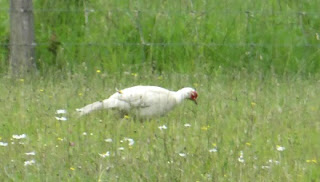Along with Jill & Ivy in the back of the Land Rover, we set off down hidden tracks & byways connecting the nest sites.
With nerves of steel Pete scales the tree & once secured:
Where their vital statistics are noted:
Weight.
Wing length.
Care is taken when correctly fitting the ring.
The first nest held two 6 to 7 week old chicks weighing 980 & 680 grams & with wing lenghts of 305 & 260mm respectively.
It surprised me how calm the birds remained, lying motionless as the process is carried out. Three more nests held single chicks, while three nests were adjudged to have failed. It is thought that a shortage of food is the most likely cause of these nest failures. Nowadays broods have dropped to an average of 1.3 chicks per nest, down from 2.1 chicks back in the early days of the release project. Broods of 4 chicks used to be recorded occasionally in the the early days but it is now unusual to get a brood of 3 and most nests have a single chick. With the birds exercising a kind of natural birth control, due to the amount of food available to sustain the population.
Two more birds were ringed at ground level & noted in the book, while Pete ringed a single bird in an inaccessible nest. Ironically one nest was situated in a Pheasant release pen.
This looks like the fun bit, coming down.
Female Red Kites moult as they incubate their eggs, which would make sense with all that sitting around going on, this is one of several feathers found below the nest sites.
While on out travels we also noted a pair of Ravens, with several Chiffchafs & Blackcaps singing.
A distant white Pheasant.
Brown Hare, several Fallow Deer one of which was dragging a heavily clubbed hind hoof, a single Roe Deer & a Fox.
Don.
Pete's eye view of today's nests:
Nest's found earlier in the season with some interesting items (seems Shakespeare's words ring true) :




























No comments:
Post a Comment